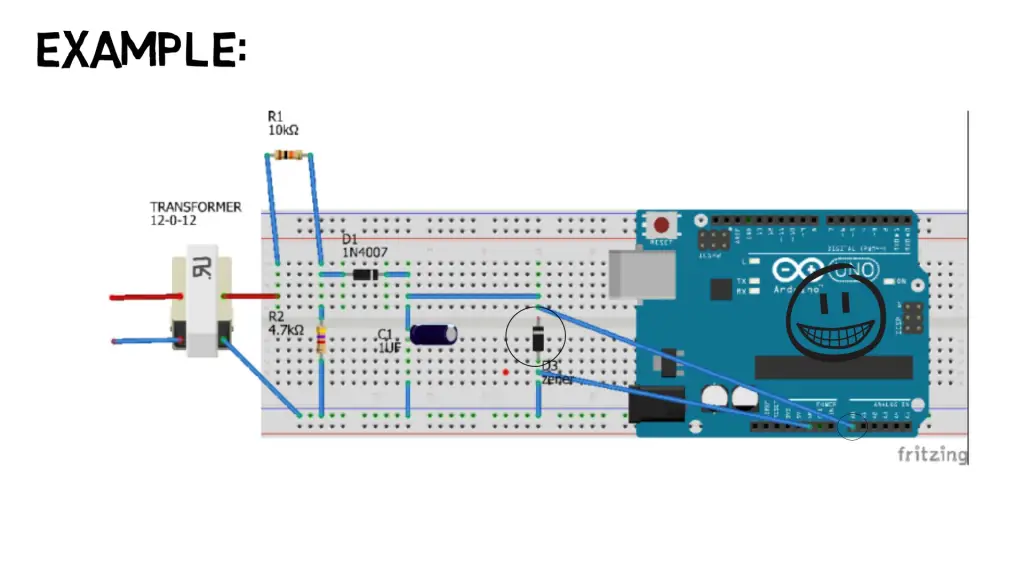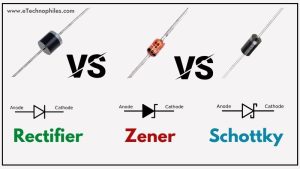Last updated on March 22nd, 2024 at 04:12 pm
A diode is a two-terminal electronic component that conducts electricity in one direction and blocks the flow of electricity in the opposite direction. There are many different types of diodes, but the most common are rectifier, Zener, and Schottky diodes.
We will discuss each of these diode in detail later on. But first, let’s quickly go through the differences between them.
| Feature | Rectifier | Schottky | Zener |
|---|---|---|---|
| Basic Function | Converts AC to DC | High-speed switching | Voltage Regulation |
| Forward Voltage Drop | 0.6V – 0.9V | 0.2V – 0.5V | 0.3V – 1.0V |
| Reverse Recovery Time | Longer | Very Short (Negligible) | |
| Reverse Breakdown Voltage | No | No | High |
| Reverse Leakage Current | Low | Very Low | Higher than rectifier |
| Maximum Forward Current | Higher | Moderate to High | Moderate to High |
| Applications | Power Supplies, Rectification | High-Frequency Circuits, Switching | Voltage Regulation, Overvoltage Protection |
Watch the video tutorial here:
Table of Contents
Before jumping to a specific diode type, let’s look at some of the basic characteristics of a diode.
Basic characteristics of a diode
| Characterstics | Definition |
|---|---|
| Vf | It indicates the forward voltage drop when current flows from the P to N terminal of the diode. |
| If | The amount of current that flows when a diode is reverse-biased. |
| VR | It is the reverse breakdown voltage when current flows from the N to P terminal. |
| IR | The amount of current that flows when a diode is reverse biased. |
| TRR | When a diode is switched off suddenly, the fwd current flowing through the diode takes a small amount of time to die down and this time is called reverse recovery time. |
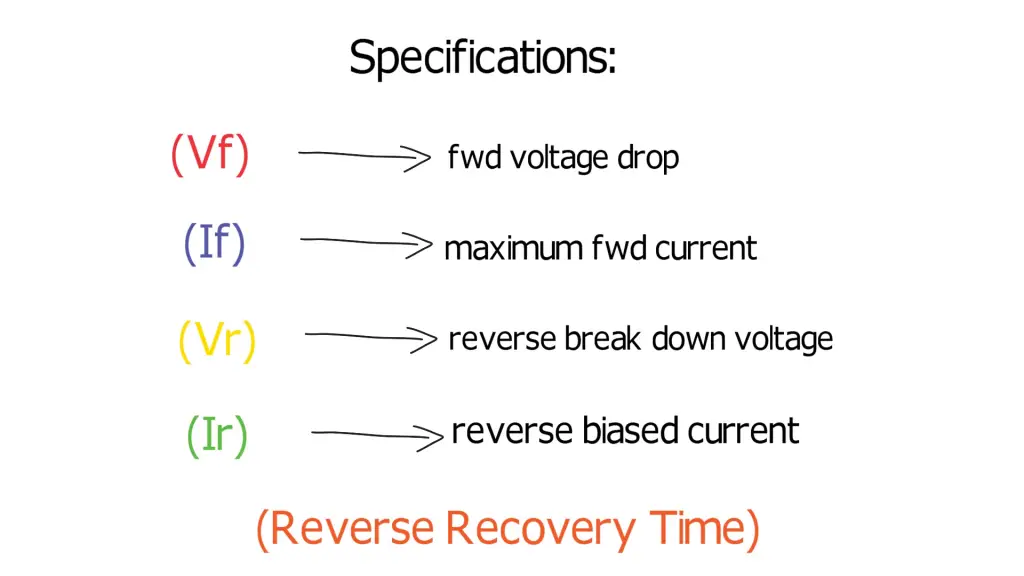
These are general characteristics and may vary depending on specific diode models and manufacturers.
What is the recovery time of a diode?
When a diode is switched off suddenly, the forward current flowing through the diode takes a small amount of time to die down. This time is called Reverse Recovery Time.
Now let’s study each diode one by one
Rectifier diode
A rectifier diode is the simplest p-n junction diode, used mostly for rectification purposes in a half-bridge and full-bridge rectifier, hence the name. Due to its high breakdown voltage, typically in the order of 200 to 1000 volts, it is used in a rectifier circuit.
A rectifier diode’s forward voltage drop (Vf) is between 0.6 to 0.9 volt.
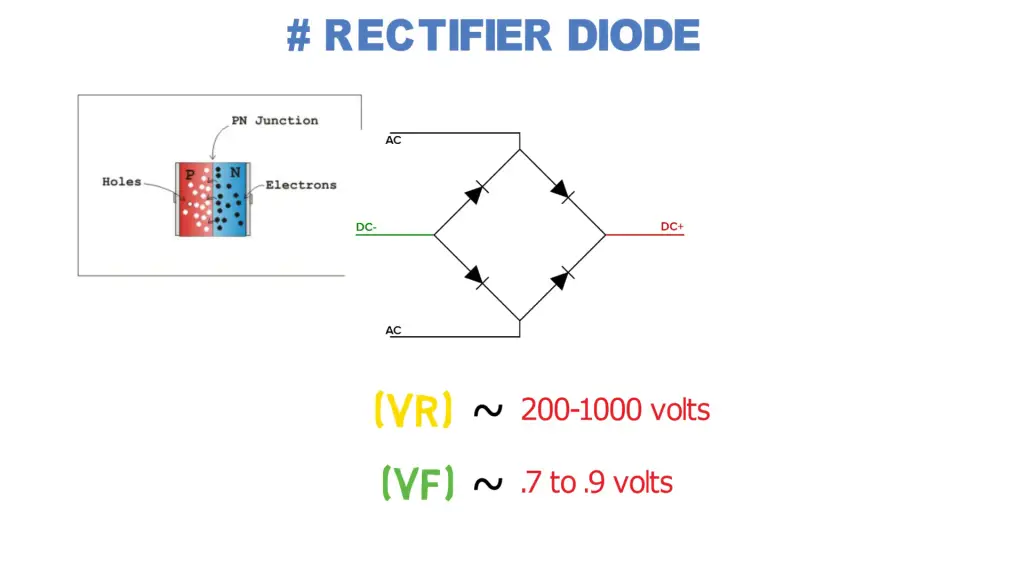
As an example, let’s say you want to design a bridge rectifier for your AC to DC converter project. For this bridge rectifier, the diode of the 1N4 rectifier series is a good choice.
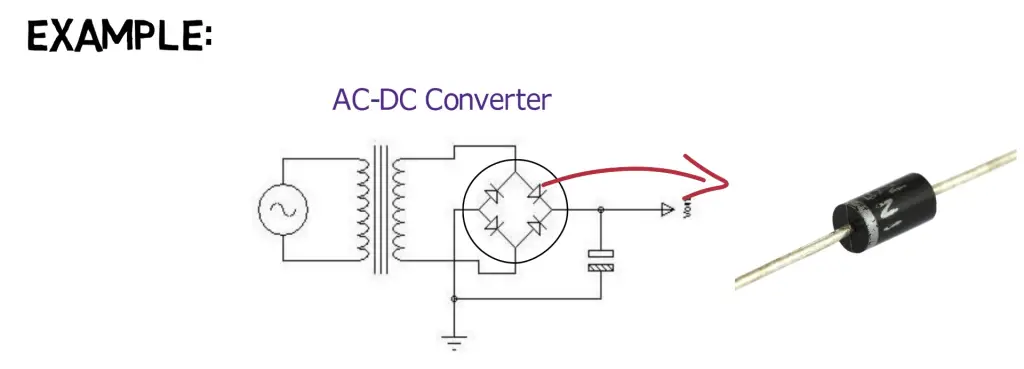
Schottky diode
Unlike a simple rectifier diode(like 1N4007), the junction of the Schottky diode is between an n-type semiconductor and a metal plate. Also, electrons are the majority charge carriers on both sides of the junction, thus it is a unipolar device.
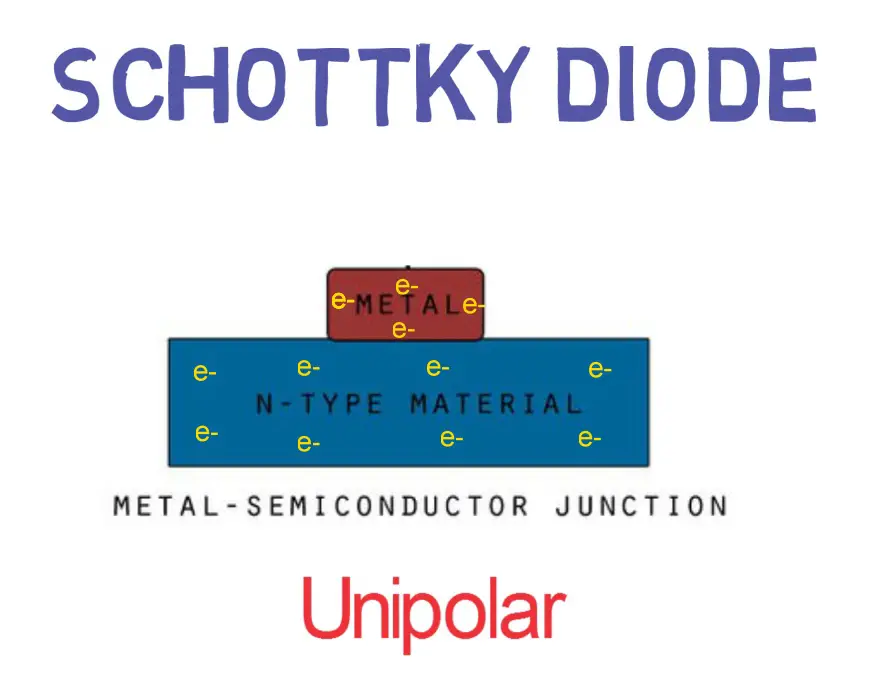
Schottky diode, also known as barrier diode is mainly used in low voltage circuits because the forward voltage drop of the Schottky diode(Vf) is less than a rectifier diode. The forward voltage drop of a Schottky diode is typically in the range of .25 to 0.5 V whereas the Vf of a rectifier diode is around 0.7 volts.
Let’s say you are working with a low voltage(say 3v) circuit and a diode is being used in that circuit. In this case, it is better to use a Schottky diode because there would be less voltage drop across it. And there will be enough voltage left for further use.
It is mostly used in high-frequency applications like SMPS because of its low thermal resistance and high switching speed due to its small recovery time.
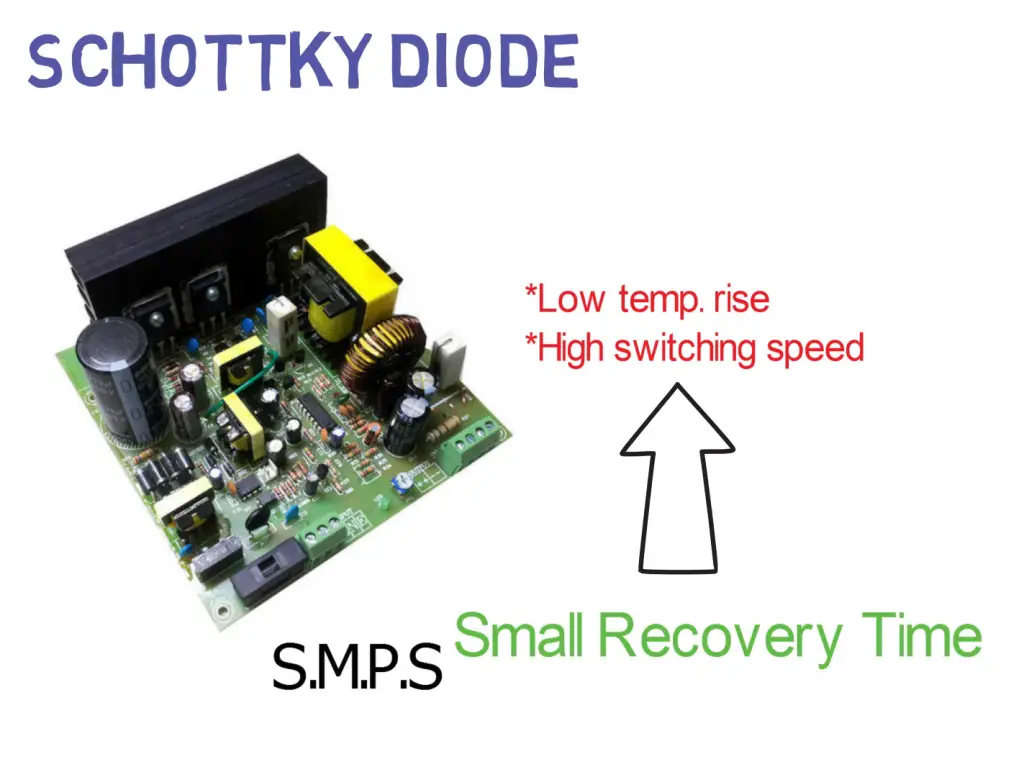
Note: Compared to a normal rectifier diode, the reverse recovery time of a Schottky diode is much smaller. This makes it suitable to be used in fast-switching circuits.
Disadvantages
One disadvantage of Schottky diode is its low breakdown voltage ( 20v to 40v ) making it unsuitable for a rectifier circuit.
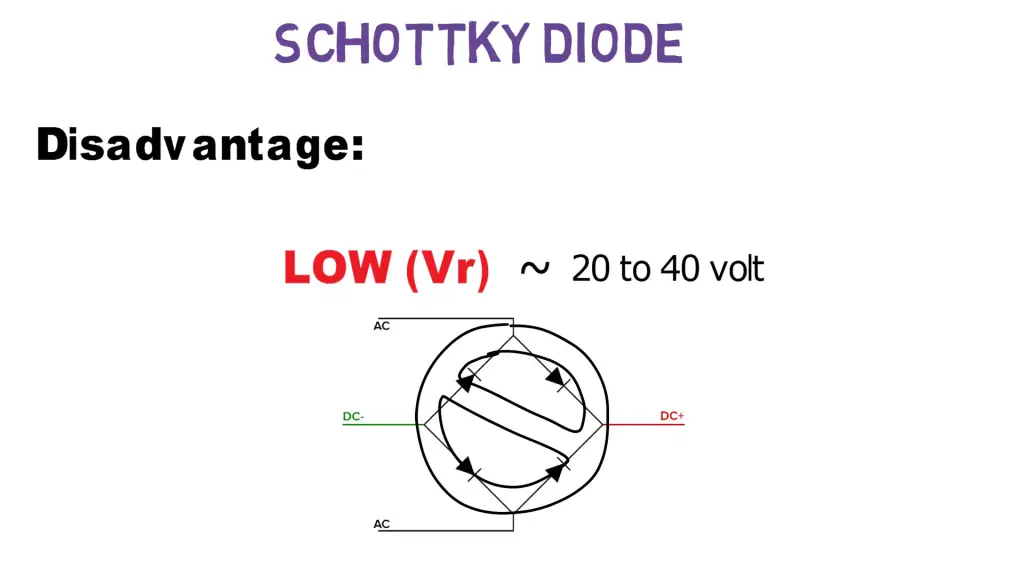
They are more sensitive to ambient temperature changes than p-n junction diodes, which can lead to performance issues in some applications.
They also have a higher reverse leakage current than p-n junction diodes, which can be an issue in power-efficient designs.
As an example, let’s say we are designing a buck converter. Since Mosfet in a buck converter switches with a very high frequency, the diode in this circuit should have a high switching speed. Thus Schottky diode can be used in this circuit.
Application of a Schottky diode
- Used in high-frequency circuits.
- Schottky diode is used as a low voltage detector.
- Schottky diode is used as a frequency discriminator.
Zener diode
A Zener diode is also made up of a PN junction but is heavily doped compared to a normal diode. As a result, it can undergo breakdown without being damaged.
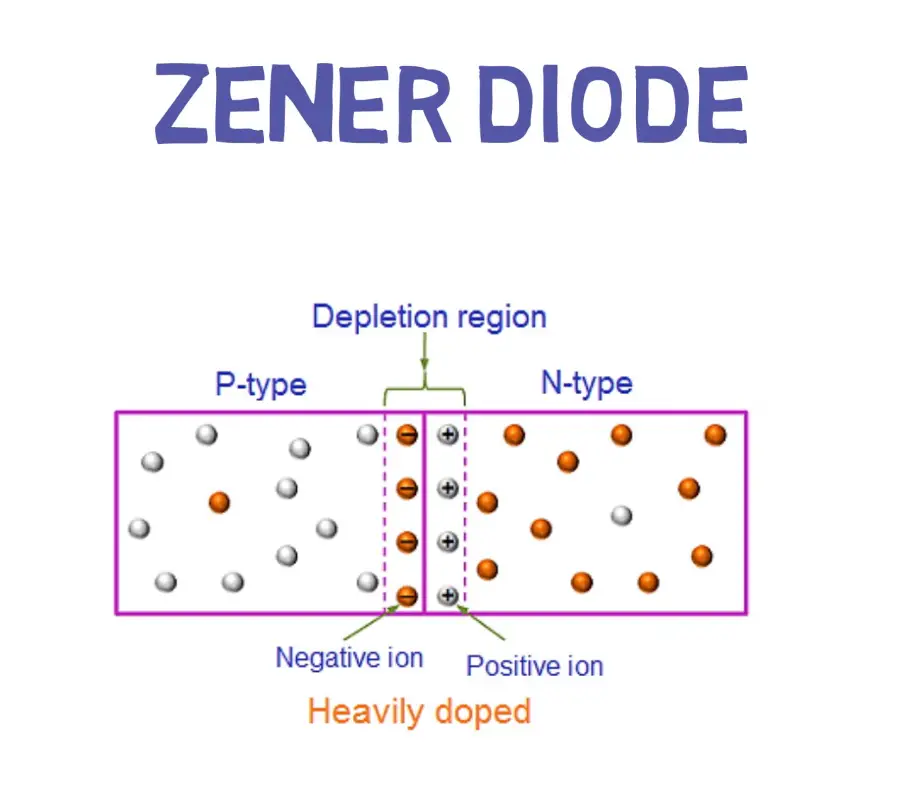
Due to this property only, Zener is used as a voltage regulator in electronic circuits. In fact, they are never used for rectification purposes.
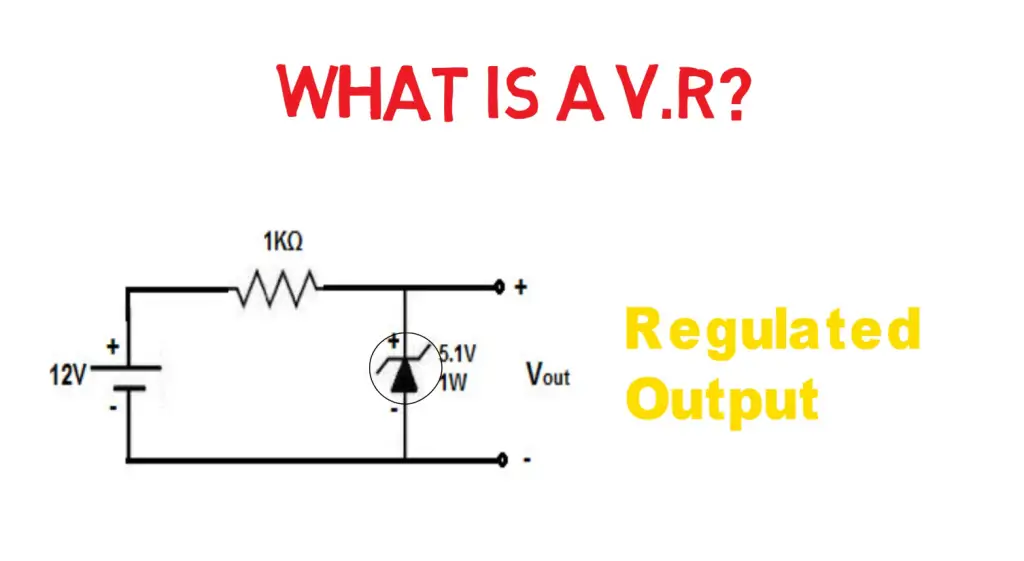
In the circuit given below, a Zener diode is used to prevent the MOSFET gate from being destroyed by clipping off the voltage.
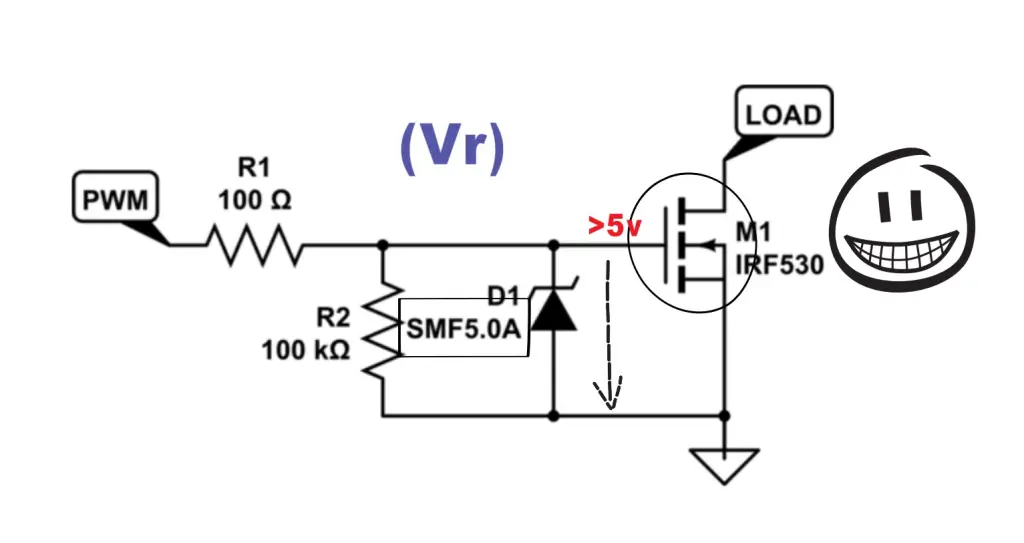
The breakdown voltage of the above Zener diode is 5.1 volts. When the voltage at the gate of MOSFET exceeds 5.1V, the diode breaks down. This causes all the current to flow through the diode to the ground. Thus preventing the Mosfet from getting destroyed.
Here’s another circuit in which two Zener diodes are connected facing each other’s p terminal.
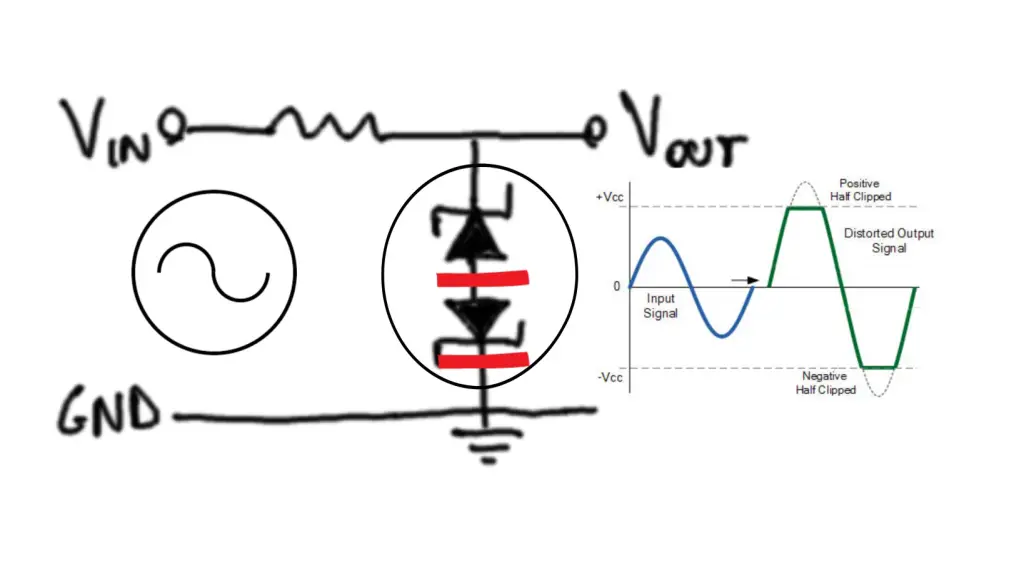
If an A.C signal is given at the input, one diode clips of voltage in the positive half whereas the other in the negative half, and thus we get voltage under the specified limit in both the half cycle of the input A.C voltage.
What are the disadvantages of a Zener diode?
Zener diodes have some disadvantages that should be considered before using them in a circuit.
- The first disadvantage is that they have a relatively low breakdown voltage, which means that they can only be used with low voltages.
- Also, they are not as efficient as other types of diodes, and they can generate a fair amount of heat when in use.
- Not well suited for use in high-frequency circuits, as they tend to produce a great deal of electrical noise.
Applications
1. They are typically used in voltage regulation circuits. They allow current to flow in the forward direction when acted upon by a voltage above the breakdown voltage, known as the Zener voltage.
However, when the voltage across the diode reaches the Zener voltage, the diode breaks down and the current flows freely in the reverse direction. This behavior can be exploited in order to create a stable voltage regulator circuit.
2. Another common application for Zener diodes is in reference circuits. Reference circuits are used to create a stable voltage that can be used as a reference point for other circuits. By using a Zener diode in a reference circuit, it is possible to create a highly accurate reference voltage.
3. They can be used in surge suppressor circuits. Surge suppressor circuits are used to protect electronic devices from damage caused by sudden spikes in voltage. By placing a Zener diode across the power supply lines, it is possible to effectively clamp the voltage to a safe level, preventing damage to sensitive electronic components.
As an example, A 5V Zener diode is used in the project “Digital voltmeter using Arduino”. It is connected across the capacitor(analog pin) to prevent the Arduino in case the voltage at its analog pin exceeds the 5 volts limit.
